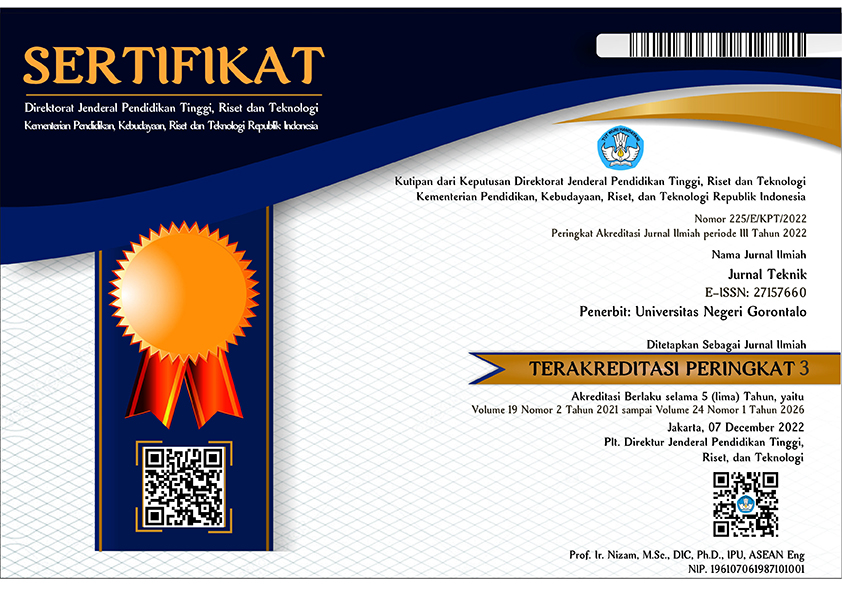Architecture Students' Perception of AI in Academic Project Resolution
Abstract
This study aims to examine architecture students' perceptions of the role of artificial intelligence (AI) in supporting the completion of academic tasks, ranging from text-based assignments to design processes. Data were collected through an online survey using Google Forms with semi-open and closed-ended questions, involving 289 undergraduate architecture students from six universities in Sulawesi Island. Data analysis was conducted using descriptive statistics and Chi-Square tests with SPSS version 26. The findings indicate that AI is well-received by architecture students, despite their limited understanding of the technology, highlighting the need for enhanced AI training and educational courses in academic institutions. Currently, AI is primarily used for non-design tasks; however, there is significant potential for AI applications in design processes. These tools can enhance students' creativity by facilitating brainstorming and providing inspiration. A balanced implementation of AI is crucial to mitigate potential negative impacts on originality and credibility. This study underscores the importance of developing AI technologies that are more relevant to the needs of architectural education and targeted training to maximize the benefits of AI in both academic and professional contexts.
Downloads
References
Al-tkhayneh, K., Alghazo, E., & Tahat, D. (2023). The Advantages and Disadvantages of Using Artificial Intelligence in Education. Journal of Educational and Social Research, 13, 105. https://doi.org/10.36941/jesr-2023-0094
Amer, N. (2023). Architectural Design in The Light of AI Concepts and Applications. MSA Engineering Journal, 2(2), 628–646. https://doi.org/10.21608/msaeng.2023.291906
Aoun, J. E. (2017). Robot-Proof: Higher Education in the Age of Artificial Intelligence. The MIT Press. https://doi.org/10.7551/mitpress/11456.001.0001
Bölek, B., Tutal, O., & Özbaşaran, H. (2023). A systematic review on artificial intelligence applications in architecture. Journal of Design for Resilience in Architecture and Planning, 4(1), 91–104. https://doi.org/10.47818/drarch.2023.v4i1085
Borglund, C. (2022). Artificial Intelligence in Architecture and its Impact on Design Creativity : A Study on how Artificial Intelligence Affect Creativity in the Design Process (Issue 22464). KTH, Real Estate and Construction Management.
Çelik, T. (2023). The Role of Artificial Intelligence for The Architectural Plan Design: Automation in Decision-making. Proceedings of the 2023 8th International Conference on Machine Learning Technologies, 133–138. https://doi.org/10.1145/3589883.3589903
Chaillou, S. (2021). AI & Architecture – An Experimental Perspective. In The Routledge Companion to Artificial Intelligence in Architecture (1st Edition, pp. 420–441). Routledge.
Chen, J., Wang, D., Shao, Z., Zhang, X., Ruan, M., Li, H., & Li, J. (2023). Using Artificial Intelligence to Generate Master-Quality Architectural Designs from Text Descriptions. Buildings, 13(9). https://doi.org/10.3390/buildings13092285
Cudzik, J., Nyka, L., & Szczepański, J. (2024). Artificial intelligence in architectural education - green campus development research. Global Journal of Engineering Education, 26, 20–25.
Cudzik, J., & Radziszewski, K. (2018). Artificial Intelligence Aided Architectural Design.
Desouki, M., El-Haddad, T. A., & El-Boshey, B. (2023). Revolutionary Artificial Intelligence Architectural design solutions; is it an opportunity or a threat? Mansoura Engineering Journal, 48(6). https://doi.org/10.58491/2735-4202.3091
Dunaevskiy, E., Lisova, A. P., & Besedina, A. R. (2022). PROSPECTS FOR THE DEVELOPMENT OF THE USE OF ARTIFICIAL INTELLIGENCE IN DESIGN AND CONSTRUCTION. Regional Problems of Architecture and Urban Planning. https://api.semanticscholar.org/CorpusID:258965014
F. J. Pinzolits, R. (2023). AI in academia: An overview of selected tools and their areas of application. MAP Education and Humanities, 4(1), 37–50. https://doi.org/10.53880/2744-2373.2023.4.37
Fitriyanto, D. A., & Zakariya, A. F. (2023). Evolusi Peran Arsitek di Era Artificial Intelligence dan Teknologi Berbasis Data. Jurnal Arsitektur TERRACOTTA | No.1 |, 5(1), 23–29.
Haenlein, M., & Kaplan, A. (2019). A Brief History of Artificial Intelligence: On the Past, Present, and Future of Artificial Intelligence. California Management Review, 61(4), 5–14. https://doi.org/10.1177/0008125619864925
Harapan, A., Indriani, D., Rizkiya, N., & Azbi, R. (2021). Artificial Intelligence in Architectural Design. International Journal of Design (INJUDES), 1(0). https://doi.org/10.34010/injudes.v1i1.4824
Hardi, R., Pee, A. N. C., Abdullah, M. H. L. Bin, Pitogo, V. A., Pribadi, A. S., & Rusdi, J. F. (2022). Academic Smart Chatbot to Support Emerging Artificial Intelligence Conversation. 2022 International Conference of Science and Information Technology in Smart Administration (ICSINTESA), 194–199. https://doi.org/10.1109/ICSINTESA56431.2022.10041632
Holmes, W., Bialik, M., & Fadel, C. (2019). Artificial Intelligence in Education. Promise and Implications for Teaching and Learning.
Jaruga-Rozdolska, A. (2022). Artificial intelligence as part of future practices in the architect’s work: MidJourney generative tool as part of a process of creating an architectural form. 95–104. https://doi.org/10.37190/arc220310
Krausková, V., & Pifko, H. (2021). Use of Artificial Intelligence in the Field of Sustainable Architecture: Current Knowledge. Architecture Papers of the Faculty of Architecture and Design STU, 26(1), 20–29. https://doi.org/doi:10.2478/alfa-2021-0004
Luckin, R., & Holmes, W. (2016). Intelligence Unleashed: An argument for AI in Education.
Memon, M., Ting, H., Cheah, J.-H., Ramayah, T., Chuah, F., & Cham, T.-H. (2020). Sample Size for Survey Research: Review and Recommendations. Journal of Applied Structural Equation Modeling, 4, i–xx. https://doi.org/10.47263/JASEM.4(2)01
Nasrullah, A., Fais Giffari, M., Hidayat, T. S., Achmad, F. S. R., & Muhlis, M. F. M. (2023, June 26). Efektivitas Kecerdasan Buatan VerasAI sebagai Referensi Desain Fasad Mahasiswa Arsitektur. Prosiding Seminar Nasional Dies Natalis Ke-62. https://journal.unm.ac.id/index.php/Semnasdies62/index
Playfoot, D., Quigley, M., & Thomas, A. G. (2024). Hey ChatGPT, give me a title for a paper about degree apathy and student use of AI for assignment writing. The Internet and Higher Education, 62, 100950. https://doi.org/https://doi.org/10.1016/j.iheduc.2024.100950
Popenici, S. A. D., & Kerr, S. (2017). Exploring the impact of artificial intelligence on teaching and learning in higher education. Research and Practice in Technology Enhanced Learning, 12(1), 22. https://doi.org/10.1186/s41039-017-0062-8
Reffat, R. M. (2002). Utilization of Artificial Intelligence Concepts and Techniques for Enriching the Quality of Architectural Design Artifacts. Proceedings of the International Conference in Information Systems.
Sadek, M. R., & Mohamed, N. A. G. (2023). Artificial Intelligence as a pedagogical tool for architectural education: What does the empirical evidence tell us? MSA Engineering Journal, 2(2), 133–148. https://doi.org/10.21608/msaeng.2023.291867
Selwyn, N. (2019). Should robots replace teachers? AI and the Future of Education (1st ed). Cambridge UK : Polity Press.
Setiawan, A., & Luthfiyani, U. (2023). Penggunaan ChatGPT Untuk Pendidikan di Era Education 4.0: Usulan Inovasi Meningkatkan Keterampilan Menulis. https://doi.org/10.36232/jurnalpetisi.v4i1.3680
Stone, A. (2023). Student Perceptions of Academic Integrity: A Qualitative Study of Understanding, Consequences, and Impact. Journal of Academic Ethics, 21(3), 357–375. https://doi.org/10.1007/s10805-022-09461-5
Suharmawan, W. (2024). Pemanfaatan Chat GPT Dalam Dunia Pendidikan. Education Journal : Journal Educational Research and Development, 7(2), 158–166. https://doi.org/10.31537/ej.v7i2.1248
Copyright (c) 2024 Wahyu Saputra Saputra, Ulfaizah Sahril Nurfadhilah (Author)

This work is licensed under a Creative Commons Attribution-ShareAlike 4.0 International License.













